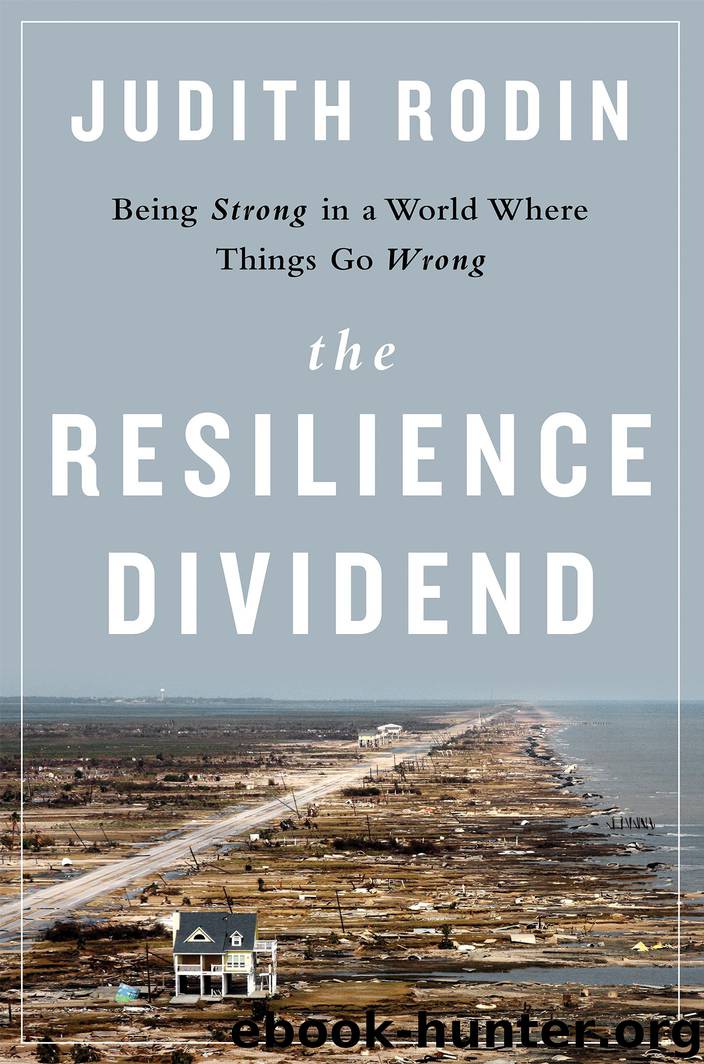The Resilience Dividend: Being Strong in a World Where Things Go Wrong by Judith Rodin

Author:Judith Rodin
Language: eng
Format: mobi, epub
Publisher: Perseus Books, LLC
Published: 2014-09-23T21:00:00+00:00
TOOLS AND TECHNOLOGIES SUPPORT ACTION
All of these entities—individuals and organizations, official and unofficial responders—benefit from the use of tools and technologies that increase awareness, enable response, and limit damage.
The dynamite used by the Army in the response to the 1906 San Francisco proved not to be the best application of technology, but the assessment of the damage was greatly facilitated by a very different technology that was then in the process of development. A well-known photographer and inventor, George Lawrence, had been experimenting with aerial photography—the first to do so—for several years. After the quake, Lawrence rigged a large-format camera (its negative measured 18” × 48”) to a multikite apparatus he dubbed “Captain Airship,” flew it some two thousand feet above San Francisco, and captured images that enabled a block-by-block visual analysis of the city and the damage it had suffered.35
In the age of Google maps, we expect to be able to access an aerial view of almost any location on earth, but in 1906 such an understanding had to be pieced together from information gathered at street level. Lawrence’s photo was a revelation about how important good information—especially information that provides perspective and facilitates new understanding that we cannot directly gain with our own senses—is to developing the best response to a crisis. Although Lawrence made his photograph three weeks after the quake hit, it was still highly useful in understanding what areas of the city were most in need of attention.36
The twenty-first-century version of Lawrence’s kite-borne camera is the drone. The “unmanned aircraft system,” as the Federal Aviation Administration classifies the drone, has the capability to fly high above a disruption, out of harm’s way, and also to dip low for a closer view. There is no onboard operator, so the device can be deployed in situations that would be life threatening to a pilot, and drones can be activated more quickly and easily than can conventional aircraft.
A videographer, photojournalist, and storm chaser named Brian Emfinger demonstrated the value of the drone when a tornado struck the town of Mayflower, Arkansas, in April 2014. After the worst of the winds had subsided, he sent up a small drone equipped with a video camera. The drone traveled smoothly along the path of the tornado at an altitude of about 150 feet, sometimes hovering over a particular site, providing a great deal of useful information about conditions immediately after the storm. The video shows damage to buildings and infrastructure, the location of emergency response vehicles, traffic buildups, and downed power lines and trees.37 The local TV station, KATV (where Emfinger worked at the time), picked up the footage.
Download
The Resilience Dividend: Being Strong in a World Where Things Go Wrong by Judith Rodin.epub
This site does not store any files on its server. We only index and link to content provided by other sites. Please contact the content providers to delete copyright contents if any and email us, we'll remove relevant links or contents immediately.
The Secret History by Donna Tartt(18732)
The Social Justice Warrior Handbook by Lisa De Pasquale(12076)
Thirteen Reasons Why by Jay Asher(8731)
This Is How You Lose Her by Junot Diaz(6696)
Weapons of Math Destruction by Cathy O'Neil(6080)
Zero to One by Peter Thiel(5632)
Beartown by Fredrik Backman(5541)
The Myth of the Strong Leader by Archie Brown(5369)
The Fire Next Time by James Baldwin(5194)
How Democracies Die by Steven Levitsky & Daniel Ziblatt(5092)
Promise Me, Dad by Joe Biden(5034)
Stone's Rules by Roger Stone(4986)
100 Deadly Skills by Clint Emerson(4792)
A Higher Loyalty: Truth, Lies, and Leadership by James Comey(4780)
Rise and Kill First by Ronen Bergman(4650)
Secrecy World by Jake Bernstein(4591)
The David Icke Guide to the Global Conspiracy (and how to end it) by David Icke(4548)
The Farm by Tom Rob Smith(4403)
The Doomsday Machine by Daniel Ellsberg(4373)
